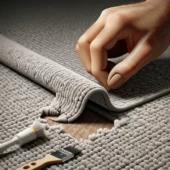Pet odors in carpets can be a persistent and unpleasant issue for many homeowners. While pets bring joy and companionship, they can also bring challenges, especially when it comes to maintaining clean and fresh-smelling carpets. This guide explores the top methods for effectively removing pet odors from carpets, ensuring your home remains a welcoming and comfortable environment.
Key Takeaways
- Enzyme treatments can break down odor-causing residues effectively.
- Professional carpet cleaning services can deep clean and remove embedded odors.
- Baking soda is a simple and natural solution for absorbing pet odors.
- A mixture of white vinegar and water can help neutralize odors.
- Regular vacuuming and steam cleaning are essential for maintaining odor-free carpets.
1. Enzyme Treatments

Enzyme treatments are a powerful method for removing pet odors from carpets. These treatments utilize bio-enzymes that actively break down the bacteria responsible for the odors, effectively eliminating the source of the problem. Enzyme-based cleaners are particularly effective because they target odors at a molecular level, ensuring a deeper and more permanent removal.
Precautions and Usage
When using enzyme treatments, certain precautions should be observed:
- Use a face mask to avoid inhalation.
- Keep the product away from children and pets.
- Ensure proper ventilation by keeping windows and doors open during use.
Repeated applications may be necessary for complete odor removal, but the safety and efficacy of these treatments make them a preferred choice for many pet owners.
Enzyme treatments not only remove odors but also offer a safer alternative to traditional chemical cleaners, making them ideal for households with pets and children.
2. Professional Carpet Cleaning

When dealing with persistent pet odors, sometimes home remedies just don’t cut it. Professional carpet cleaning services offer a robust solution, utilizing advanced equipment and specialized cleaning solutions that can effectively tackle deep-set odors and stains. Regular professional cleaning not only helps in maintaining a fresh-smelling home but also extends the life of your carpet.
Professional carpet cleaners can succeed where DIY methods fail, providing a deeper, more thorough clean that addresses both stains and underlying odors.
For optimal results, consider scheduling professional cleaning services periodically. This proactive approach ensures that odors and stains are managed before they become more severe, maintaining the aesthetic and hygienic quality of your carpets.
3. Baking Soda

Baking soda is a highly effective and inexpensive way to remove pet odors from carpets. Simply sprinkle a thin, even layer of baking soda over the affected area of your carpet. Allow it to sit overnight to absorb the odors fully. The next day, vacuum the baking soda thoroughly to remove all traces of powder. This method is particularly useful for freshening up the carpet without the need for harsh chemicals.
Baking soda not only neutralizes odors but also acts as a natural cleaning agent that doesn’t leave behind any harmful residues.
For best results, you can also mix baking soda with distilled white vinegar to tackle more stubborn stains and odors. Apply the mixture to the carpet, let it sit for a few hours, and then vacuum as usual. This combination is effective because vinegar kills germs while baking soda absorbs odors and adds a fresh scent.
4. White Vinegar and Water Solution

Using a white vinegar and water solution is a highly effective and eco-friendly method for removing pet odors from carpets. To prepare the solution, mix equal parts of distilled white vinegar and water in a spray bottle. Before applying, test the solution on a small, inconspicuous area of your carpet to ensure it does not affect the color or texture.
Steps for Application:
- Spray the vinegar solution liberally on the affected area of the carpet.
- Allow the solution to sit for 5-10 minutes to break down the odors.
- Blot the area with a clean, dry towel to absorb the vinegar and lifted odors.
- If the odor persists, repeat the process or consider a more diluted formulation (1/2 cup vinegar to one gallon of warm water) for sensitive carpets.
This method not only helps in odor removal but also acts as a mild disinfectant due to vinegar’s natural antibacterial properties.
5. Steam Cleaning

For deep-set odors and stains, steam cleaning is a highly effective method. This process involves using hot water and sometimes a cleaning solution to penetrate deep into the carpet fibers, helping to extract stubborn odors and stains. You can either rent a steam cleaner from a local store or opt for professional carpet cleaning services which often include steam cleaning as a part of their offerings.
Steam cleaning not only removes odors and stains but also kills bacteria and dust mites, making it an excellent choice for maintaining a healthy living environment.
Steps for Effective Steam Cleaning:
- Vacuum the carpet thoroughly to remove any loose dirt and debris.
- Pre-treat any stains with a suitable cleaning solution to improve the effectiveness of the steam cleaning.
- Fill the steam cleaner with hot water and, if recommended by the manufacturer, a cleaning solution.
- Slowly move the steam cleaner over the carpet, ensuring that each section is covered evenly.
- Allow the carpet to dry completely, which may take several hours depending on the ventilation and air humidity.
By following these steps, you can ensure that your carpet is not only clean but also free from any harmful allergens and bacteria.
6. Vacuuming

Regular vacuuming is a crucial step in removing pet odors from carpets. The effectiveness of vacuuming largely depends on the quality of the vacuum cleaner and the technique used. For optimal results, it is recommended to use a high-quality vacuum with powerful filters that can trap even the smallest particles, such as the Dreame V11 Vacuum Cleaner. These filters should be replaced monthly to maintain their efficiency.
Key Steps for Effective Vacuuming:
- Move the vacuum slowly and in straight lines to maximize suction and coverage.
- Ensure the vacuum moves backward while pulling, as this enhances its suction capacity.
- Regularly change the vacuum system filters to ensure they effectively trap allergens and dirt.
Vacuuming not only removes visible pet hair and dirt but also helps in reducing the allergens that can cause odors. Regular maintenance of the vacuum cleaner and proper vacuuming techniques are essential for keeping your carpets fresh and odor-free.
7. Odor Neutralizers

Odor neutralizers are essential in the battle against persistent pet odors in carpets. These products don’t just mask odors; they chemically neutralize them, ensuring that the smells are not just covered up but genuinely removed. Products like Angry Orange Odor Eliminator and Simple Solution Extreme Pet Stain and Odor Remover are designed to form a chemical bond with odor-causing molecules, rendering them inert and unable to trigger olfactory nerves.
Popular Odor Neutralizers
- Charcoal bags: Absorb odors and moisture naturally.
- Sprays: Chemically neutralize odors without harsh chemicals.
- Enzymatic cleaners: Break down odor-causing substances.
For effective odor control, it’s crucial to choose a neutralizer that suits the specific type of pet odor you’re dealing with, whether it’s urine, feces, or just the general smell of pet dander.
When applying odor neutralizers, always follow the instructions on the product label to ensure safety and effectiveness. Regular use can significantly diminish the presence of unwanted smells and contribute to a fresher, cleaner home environment.
8. Sanding the Floor

Sanding the floor is a crucial step in removing pet odors that have deeply penetrated wooden floors under carpets. This method involves removing the top layer of the wood where odors may have seeped in, providing a fresh base. It’s important to ensure that the floor is completely dry before beginning the sanding process to avoid damaging the wood.
Steps for Sanding:
- Remove all furniture and carpeting from the room.
- Ensure the floor is thoroughly dry.
- Use a sander appropriate for your floor type (e.g., orbital or belt sander).
- Sand the floor evenly, paying extra attention to stained or discolored areas.
- Clean up all sawdust and debris after sanding.
- Optionally, treat the floor with an odor-neutralizing sealant.
Sanding not only removes the odors but also prepares the floor for refinishing or sealing, which can further help in odor control and enhance the appearance of your wooden floors.
9. Sealing the Floor

Sealing the floor is a crucial step in effectively dealing with pet odors that have penetrated deep into the flooring beneath carpets. This process involves applying a sealant that acts as a barrier, preventing any residual odors from rising up through the new or existing flooring. It’s particularly important when the flooring has absorbed odors over a long period, or when other cleaning methods have failed to eliminate the smell completely.
Steps for Sealing the Floor:
- Ensure the floor is completely dry and clean from any previous cleaning methods.
- Apply a high-quality odor barrier or fungal sealant evenly across the floor.
- Allow the sealant to dry thoroughly, following the manufacturer’s recommended drying time.
- Once dry, reinstall the carpet or proceed with laying new flooring materials if necessary.
Sealing is not just about trapping odors; it also enhances the longevity of your flooring by protecting it from future stains and damage.
10. Replacing Carpet Padding

Replacing the carpet padding is often a necessary step when dealing with extensive pet odor contamination. This method ensures that all remnants of odor-causing elements are removed, especially when the urine or other contaminants have soaked deeply into the padding. Here are the steps involved in replacing carpet padding:
- Remove the old carpet carefully to avoid damaging the carpet fibers.
- Take out the old padding which may be saturated with urine or contaminated by other substances.
- Clean and sanitize the floor underneath to ensure no odor-causing residues remain.
- Install new, high-quality padding that suits the type of carpet and expected traffic.
- Reinstall the carpet over the new padding, ensuring it is properly stretched and secured.
Replacing the padding can be a more cost-effective solution than replacing the entire carpet, especially if the carpet itself is still in good condition but the padding has been compromised by odors or moisture.
When it’s time to replace your carpet padding, don’t settle for less! At Carpet Pro Cleaners, we offer top-notch carpet padding replacement services that ensure comfort and durability. Serving areas including Raleigh, Durham, Cary, and more, we’re just a click away. Visit our website to book an appointment and breathe fresh life into your home!
Conclusion
In conclusion, effectively removing pet odors from carpets requires a combination of immediate action, proper cleaning techniques, and sometimes professional intervention. From DIY solutions like vinegar and baking soda to professional-grade enzyme treatments, the key is to address spills and accidents promptly to prevent the urine from setting into the carpet fibers. Regular maintenance, such as vacuuming and timely spot cleaning, also plays a crucial role in managing pet odors. For severe cases, it may be necessary to consult with professional cleaners who can provide deep cleaning and specialized treatments to restore your carpet to a fresh, odor-free state.
Frequently Asked Questions
What are enzyme treatments and how do they help remove pet odors?
Enzyme treatments involve using biodegradable, non-toxic enzymes that break down odor-causing molecules in pet urine. These treatments effectively neutralize odors at the source by digesting the organic materials that cause smells.
Can professional carpet cleaning remove deep-set pet odors?
Yes, professional carpet cleaning can remove deep-set pet odors. Professionals use powerful equipment and specialized cleaning solutions that can reach deeper into the carpet fibers to extract odors and stains.
Is baking soda effective in removing pet odors from carpets?
Baking soda is a natural deodorizer and can be effective at absorbing pet odors when sprinkled on carpets. It’s best used by applying it to the affected area, letting it sit for several hours, and then vacuuming it up.
How does a white vinegar and water solution work for pet odor removal?
A mixture of white vinegar and water can help neutralize pet odors. The acidic nature of vinegar helps to break down the alkaline salts formed in dried urine, effectively removing the smell.
What is the role of steam cleaning in combating pet odors?
Steam cleaning uses high-temperature steam to penetrate carpet fibers, effectively removing embedded pet odors and stains. It also sanitizes the carpet, killing bacteria and allergens.
Are odor neutralizers safe to use on carpets, and how effective are they?
Odor neutralizers are generally safe for carpets and can be highly effective. They work by chemically neutralizing odor molecules, rather than just masking smells, providing a more permanent solution.



